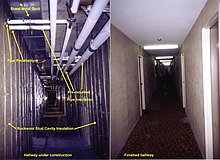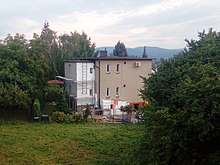
| Part of a series on |
| Sustainable energy |
|---|
 |





Building insulation is material used in a building (specifically the building envelope) to reduce the flow of thermal energy. While the majority of insulation in buildings is for thermal purposes, the term also applies to acoustic insulation, fire insulation, and impact insulation (e.g. for vibrations caused by industrial applications). Often an insulation material will be chosen for its ability to perform several of these functions at once.
Since prehistoric times, humans have created thermal insulation with materials such as animal fur and plants. With the agricultural development, earth, stone, and cave shelters arose. In the 19th century, people started to produce insulated panels and other artificial materials. Now, insulation is divided into two main categories: bulk insulation and reflective insulation. Buildings typically use a combination.
Insulation is an important economic and environmental investment for buildings. By installing insulation, buildings use less energy for heating and cooling and occupants experience less thermal variability. Retrofitting buildings with further insulation is an important climate change mitigation tactic,[1][2] especially when buildings are heated by oil, natural gas, or coal-based electricity. Local and national governments and utilities often have a mix of incentives and regulations to encourage insulation efforts on new and renovated buildings as part of efficiency programs in order to reduce grid energy use and its related environmental impacts and infrastructure costs.
- ^ Wilson, Alex (2010-06-01). "Avoiding the Global Warming Impact of Insulation". BuildingGreen. Retrieved 2021-03-28.
- ^ "Building Retrofitting @ProjectDrawdown #ClimateSolutions". Project Drawdown. 2020-02-06. Retrieved 2021-03-28.